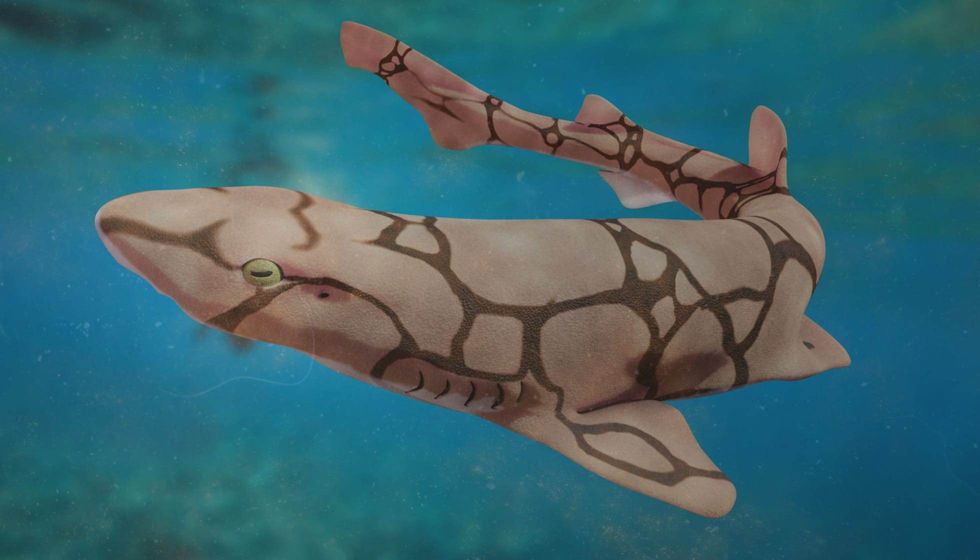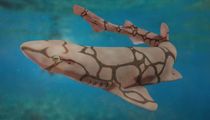The catshark is a ground shark with a commonly dark body and a protracted anal fin that ends where the caudal fin begins. They are not harmful to humans and have over 150 species.
The snouts of the catshark are flat, and they have long cat-like eyes, which gives them their name. Most of these species have patterns like stripes, patches, or spots. They are found in temperate and tropical seas around the world. Since they are nocturnal, some species spend the days together in groups near crevices and go hunting at night.
Some catsharks are also poor at migrating long distances as their swimming is not exactly the best. Most catsharks also lay their eggs on the sea bed in tough egg cases known as 'mermaid's purses' for protection.
If you like these facts, then you should definitely read our articles on the Port Jackson shark and the tiger shark.
Catshark Interesting Facts
What type of animal is a catshark?
Cat sharks, also known as dogfish, are seabed sharks of the family Scyliorhinidae. They are certainly considered one of the biggest families of sharks, with approximately 150 species positioned in 17 genera.
What class of animal does a catshark belong to?
The catshark (Scyliorhinus) is a cat-like shark that belongs to the Chondrichthyes class of the animal kingdom.
How many catsharks are there in the world?
There is no estimate on how many catsharks are there in the world, but they are in abundance as they have been categorized as Least Concern by the IUCN Red List, so we humans needn't worry about their conservation.
Where does a catshark live?
The distribution of the catshark (dogfish) species is spotted in seabeds in temperate and tropical seas worldwide, ranging from shallow intertidal waters to depths of 6,562 ft (2,000 m). The red-spotted catshark lives within the shallower rocky waters, and the distribution from Peru to Chile and migrates to deeper waters.
What is a catshark's habitat?
The catshark (dogfish) species can stay in various habitats, with species that stay in saltwater, freshwater, and brackish water. Some catfish pick stagnant water, and others pick rivers and streams with fast transferring currents as their habitat; all of it depends on the species.
Channel catfish usually pick clean water streams as habitats and are also common in muddy water. During the day, they are generally located in deep holes where the protection of logs and rocks may be observed in the habitats.
Most motion and feeding activity takes place at nighttime, after sundown, and earlier than sunrise. Young channel catfish regularly feed in shallow riffle regions, and the adults appear to feed in deeper waters that are downstream from sand bars.
Adults hardly ever migrate from one location to the other and are often termed to be poor swimmers. However, the younger fish tend to move much more than the adults, especially at night to feed themselves.
Who do catsharks live with?
Catsharks differ in their social behaviors. Some dogfish species stay in a group of sharks to look out for predators. Other species remain in solitude and use camouflage to cover and hide from predators. Most species, however, like staying in groups. Different species have distinctive social behaviors based totally upon the individual or group.
How long does a catshark live?
A small-spotted catshark can live till the maximum age of at least 12 years in South Africa, if not killed by predators. Reproductive adulthood is attained at overall lengths of 21-24 in (54-60 cm) for males and females, correlating to an age of three to nearly eight years in the oceans and the Atlantic.
How do they reproduce?
Like their social behavior, the reproduction rates and sexual behavior of these sharks range dramatically. Most species are oviparous, which concludes that most catsharks indulge in laying eggs. Their eggs are known as 'mermaid's purses,' and most species stick them to the ground, rocks, or seaweed.
Mating happens in deeper waters from the summer season all through autumn. The adult males mate while the females return to shallower spawning grounds and start laying their eggs until June and July.
As an oviparous species, the small-spotted catshark is found laying only one egg per oviduct at a time, with embryos depending entirely on the yolk for nutrition.
The huge egg case is laid in pairs on tendrils on the appropriate substrate, macroalgae in shallow water. Up to 18-20 of such egg pouches can be released every reproduction season.
The eggs of the small-spotted catshark take five to six months to hatch in captivity, with neonates measuring about 3.5-3.9 in (9-10 cm) in length. The incubation duration of the eggs is different; many species take 12 months to hatch. A few species also provide live delivery, with the females preserve the eggs till they hatch inside the uterus.
What is their conservation status?
The conservation status of the catshark species, the largest shark species that live in the world, has been categorized as Least Concern by the IUCN Red List. This is because this species of shark has its distribution all around the world's oceans, right from the coast of South Africa to the Atlantic.
C Fun Facts
What do catsharks look like?
Despite the vast existence of various species, these catsharks commonly share a similar body shape. These species have elongated bodies with lengthy tails, and their pectoral or dorsal fins normally stick outward from their bodies instead of downward.
While most species are approximately 3 ft (0.9 m) in length, they range in size from about 0.66-5 ft (0.2-1.5 m) in length.
How cute are they?
The cuteness of the catshark (dogfish) depends on different species of shark. You can spot these sharks with a dorsal fin from the coast of South Africa. The small-spotted catsharks are small and cute. Most of these sharks are adorable to look at as they mildly resemble cats.
How do they communicate?
Catsharks (dogfish), like different elasmobranchs, are highly sensitive to electric-powered fields created due to the motion of water by different fish or even the motion of the earth. This shark can use this experience to navigate the earth's magnetic fields and to locate prey.
The unique receptors used for this mode of perception are referred to as the ampullae of Lorenzini, distributed across the shark's head. The catshark (dogfish), like any different fish, judges its surroundings hydrodynamically with the lateral line, a chain of pores connecting the inner canal system with the water on the outside.
They also have pit organs that are found near the scales. These fish are well adapted to be predators and thus have keen senses of hearing, taste, and scent that assist them in locating food sources.
How big is a catshark?
The catshark (dogfish) species spotted by the coast or in the oceans have been known to grow up to 31.5-62.4 (80-158.4 cm) in length. Catsharks are ten times bigger than the sea slugs that live in the sandy bottom of the oceans.
How fast can the catshark swim?
Catsharks aren't the quickest sharks by any means. They opt to hunt with the aid of using stealth and sneaking up on their prey near the ocean floor. There haven't been any experiments that measure their top speed, but these sharks are known to be poor swimmers and hence are estimated to be slow.
How much does a catshark weigh?
Catsharks weigh according to their species. They weigh from 1.6-29.1 lb (0.7-13.2 kg).
What are the male and female names of the species?
There are no different male and female names for the catshark species.
What would you call a baby catshark?
Baby catsharks are known as juvenile catsharks and don't have separate names.
What do they eat?
These sharks are carnivores. Their diet typically relies on primary factors like their length and location, whether they like sandy bottoms or the coast. Smaller species like the small-spotted catsharks generally feed on small fish, squid, crabs, and different invertebrates.
Larger species have a diet of large fish and different prey. Species dwelling in distinctive regions devours different prey, relying on what's considerably close to them. Regardless of their species, these sharks devour different benthic organisms instead of journeying up the water column for food.
Are they aggressive?
This depends on the species of catshark. The small-spotted catshark is harmless to humans because of its feeding habits, small size, and habitat preference. Most of these species are harmless.
Would they make a good pet?
These fish do not make proper pets. However, a few humans do preserve smaller species in aquariums. Even species that might be small enough do not make suitable pets. They ought to stay in saltwater, and saltwater tanks are expensive and hard to maintain by humans.
Did you know...
Some catshark species that have been spotted are small-spotted catshark, pale catshark, false catshark, brown catshark, blackmouth catshark, striped catshark, leopard catshark, Atlantic sawtail catshark, filetail catshark, marbled catshark, Atlantic ghost catshark, gulf catshark, pygmy ribbontail catshark, jaguar catshark, Asian catshark, and cloudy catshark.
Coral catshark facts include the fact that intensive coral catshark care has to be taken as they are shy sharks with eyes that resemble a cat's and stay in shallow water around coral reefs.
The catshark tooth is replaced every 18-38 days. They have 40-110 rows of teeth.
A coral catshark egg is sold for around $100.
You can eat a catshark, and it is best served as fish and chips.
If you're looking to buy one, the price can range from $80-300. Please keep them in a tank where you ensure the optimal salinity of the water. Put sandy gravel on the bottom layer, with rocks and hiding spots and a low-to-medium powered lamp.
The acidity should be 8.2–8.4. You'll need a 350-gal (1325 l) tank. You can keep them with stingrays, yellow or hippo tangs, other catsharks, or harlequin tusks.
What can some species of catshark do?
The chain catshark is a species of catshark that can glow in the dark. Swell sharks can fill their stomach with air or water when at threat.
What do catsharks do when threatened?
The swell catshark can fill its stomachs with water or air while at threat, growing its girth three times more.
Here at Kidadl, we have carefully created lots of interesting family-friendly animal facts for everyone to discover! For more relatable content, check out these black neon tetra facts and Bolivian ram facts pages.
You can even occupy yourself at home by coloring in one of our free printable Catshark coloring pages.










